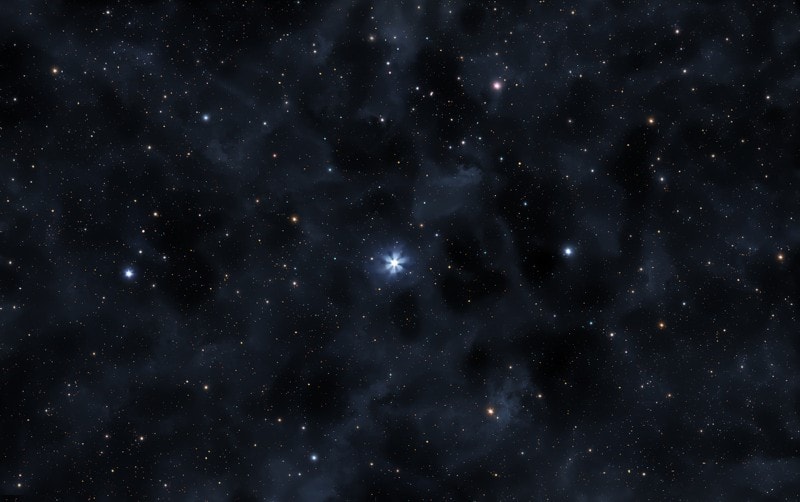What Is Atmospheric Refraction? The Interesting Answer!
Last Updated on

Did you know that light doesn’t travel in a straight line? Cool air is denser than hot air, so light bends as it travels through space and encounters atmospheric layers with varying temperatures. Unless you’re studying light in a vacuum, the light you see will always have been through this process of bending and shifting. This phenomenon is known as atmospheric refraction. It’s the reason stars twinkle and allows us to see the sunrise earlier than it actually is, while making the sun seemingly linger on earth for a couple minutes after it’s actually set. Let’s learn more about atmospheric refraction in this article.

How Does It Work?
Atmospheric refraction works by bending light rays as they reach different atmospheric layers. If light is traveling in a straight line and hits relatively cooler air, it will slow down because the air is heavier. Similarly, if you jump off a diving board, you’ll fly faster while you’re still in the air, but everyone knows your speed will slow down once you crash through the denser surface of the water. However, if you swim to the top and jump out, you’ll speed back up again as you’re able to run through air instead of treading water. Similarly, when the light ray reaches hotter air, it’ll start to move faster and bend in the opposite direction.

What Are Some Examples of Atmospheric Refraction?
Stars don’t actually twinkle way up there in the sky. And they aren’t as high as they appear, either. Atmospheric refraction alters a star’s appearance from earth because of the long distance a star’s light travels before it reaches us. As the star’s light streams through the galaxy, the rays refract, which causes the star’s light to twinkle, and appear at a higher angle than it actually is. Planets don’t twinkle simply because they’re closer, so the light doesn’t pass through as many atmospheric layers during its journey.
Refraction alters how we see the sun. The atmosphere in space is colder than earth’s atmosphere, so the light bends towards earth as it moves closer. Because the light rays are bent towards us, the image of the sun that we see is actually higher than it is physically. This results in our earlier view of the sunrise, and our later view of the sunset.
Imagine a sunset on the beach. As the sun hovers over the waters, you might notice the bottom portion tends to flatten like a disc, seeming to rest on the water’s surface. It’s also common to see a mirage where the light seems to shake around the sun. This is similar to when you see “shaky” air in a hot desert or on a scorching highway in July that can trick you into thinking you’re seeing a pool of water. All of these effects are due to atmospheric refraction.
You see the mirage because the light is passing through pockets of hot and cold air as it makes its way to your eyes. In the same way, the temperature of the asphalt highway is even hotter than the air directly above it, resulting in a mirage. The reason for the sun’s flattened disc over the ocean at sunset is a bit more complicated. This is because the light rays coming from the sun’s bottom half pass through cooler rays than the rays streaming from the sun’s upper half. Since denser light is cooler, it bends or refracts towards normal as opposed to when it passes through hotter lighter air where it bends away.
Pros & Cons of Atmospheric Refraction
Atmospheric refraction gives us almost five more minutes of sunlight each day than if light traveled to earth in a straight line. Additionally, without atmospheric refraction, our view of the galaxy would look drastically different. Can you imagine a nighttime sky without shimmering stars?
This physical process is responsible for many optical illusions. While some of them may be pretty, such as our twinkling nighttime sky, others may not be as helpful, such as believing you’ve found water in a desolate desert when you’ve really found a wavering pocket of hot air.

Frequently Asked Questions (FAQs)
Why Does Atmospheric Refraction Cause Early Sunrises and Late Sunsets?
The light bends towards us as it goes under refraction, resulting in earlier than actual sunrises and later sunsets.
What Causes Twinkling Stars? Why Don’t Planets Twinkle?
Changes in atmospheric temperatures from a long distance causes the stars to appear to twinkle from our view on earth. However, it’s only an illusion because they wouldn’t twinkle if we were able to get closer to them in space. The planets in our solar system don’t twinkle because they’re closer, so their light doesn’t have to pass through so many atmospheric layers on its trip to earth.
What Is a Mirage?
When light travels through a small region of starkly contrasting temperatures, a mirage will result as the light is rapidly refracted into waves.

Final Thoughts
Hopefully this article explained everything you need to know about atmospheric refraction. Atmospheric refraction is due to the varying density of light as it travels through a medium. Mirages, flickering stars, and slightly longer sunlight in a given day are all the result of this amazing process.
Featured Image Credit: charloisporto, Pixabay
Table of Contents
About the Author Brooke Bundy
Brooke Bundy is a freelance writer who lives with three cats and a dog. She attended the University of North Georgia where she acquired a B.S. in Media Studies. Booke loves storytelling and spending time with her pets at their house in New Orleans, Louisiana. In her free time, she enjoys gardening, cooking, and brewing coffee.
Related Articles:
What Is the Best Binocular Magnification for Hunting? Optical Features Explained
How to Clean a Refractor Telescope: Step-by-Step Guide
How to Clean a Telescope Eyepiece: Step-by-Step Guide
How to Clean a Rifle Scope: 8 Expert Tips
Monocular vs Telescope: Differences Explained (With Pictures)
What Is a Monocular Used For? 8 Common Functions
How to Clean a Telescope Mirror: 8 Expert Tips
Brightfield vs Phase Contrast Microscopy: The Differences Explained
